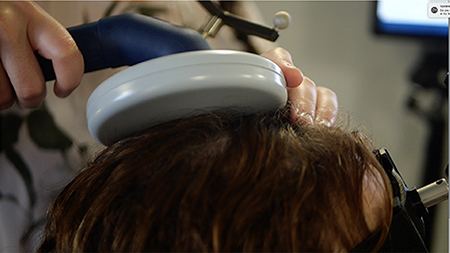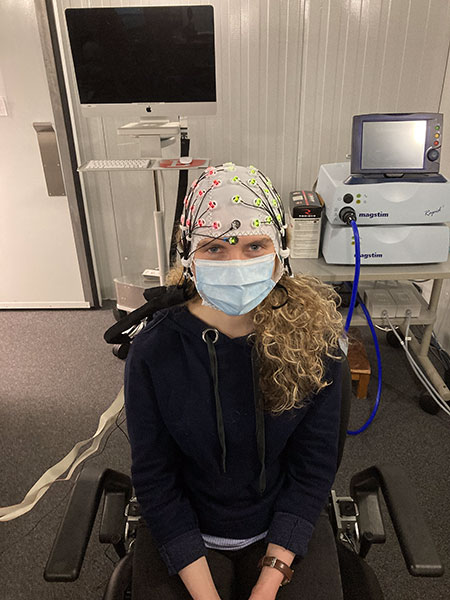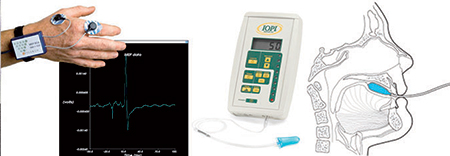Speech Lab
The lab is equipped with a large (15m2) sound-attenuated and electrically shielded room, which offers a very high level of sound attenuation because of its double wall architecture (literally, a room within a room), which isolates it from external sounds and from structural vibrations. Complete quiet, only achievable in a sound-attenuated room, is essential for speech/hearing research, which requires the presentation of sound stimuli and the recording of voice in the absence of environmental noise and structural vibrations. In addition to serving as a testing space, the sound attenuated room is used as a recording studio (which includes many different kinds of microphones, speakers, headsets, video cameras, digital recorders and dB meters), where high-quality audio and audio-visual material are used as experimental material.
Transcranial Magnetic Stimulation (TMS) Platform
TMS is a non-invasive and painless method of exciting neurons using strong, time varying magnetic fields generated by a stimulating coil held close to the scalp. Depending on the application a variety of output waveforms may be used to excite or inhibit neural responses. By studying the effect that TMS to specific areas has on behaviour we can determine the function of these areas (functional brain mapping). TMS can make people faster at speaking or slower, it can also improve or reduce response accuracy or response bias. TMS can also be used to modulate cognitive and perceptual processes. These effects, whether motor, perceptual or cognitive, only last for a few seconds to a few minutes, and generally are unnoticed by the person receiving the stimulation. Here we use TMS to modulate neural activity in cortical areas involved in speech perception and production such as the premotor cortex and the supplementary motor areas; the effect of the modulation on speech behaviour is used to understand brain/behaviour relationships. Moreover, the TMS platform is also used to study speech and swallowing disorders and develop protocols to remediate behavioural symptoms by promoting plasticity in the motor systems.
The TMS lab includes a stimulator (The Magstim Super Rapid² — a single pulse and repetitive stimulator with high frequency capabilities) and a neuronavigation system (Brainsight 2, Rogue Research). The neuronavigation system is used for on-line identification of the position of the coil taking into account individual differences in macroanatomy. This system enables the coil to be located very accurately over specific brain areas by co-registration of the coil placement relative to the participant’s head, through visualization of the coil (with a specialized camera) and a 3D brain reconstruction of each subject’s derived anatomical magnetic resonance images (MRI). This system is critical not only in correctly identifying target brain areas, but also in insuring that the stimulation remains at the same location throughout the course of an experiment, which may run for several minutes/hours.





EEG Lab
We are now equipped with a TMS-compatible 64-channel electroencephalography (EEG) system from BrainVision (actiCHamp plus with actiCAP) including an auditory brainstem potential (ABR) electrophysiological recording module. The EEG system will allow us to measure brain activity during speech and language tasks, and to study the temporal evolution of the effects of TMS on brain activity at rest and during speech and hearing tasks in adults 18 to 100 years old. The ultra-thin electrodes (actiCAP slim) allow for the simultaneous combination of TMS and EEG.
We’ve also acquired an ABR module to study subcortical auditory potentials, which are important for understanding the aging of speech processing. The particularity of the ABR module is that the amplifier must be very powerful to record signals of extremely low amplitude (typically <1μV) and very fast (these signals occur between 0 and 10 ms after the presentation of a sound).
Our EEG system uses active electrodes (first amplification at the electrode) which allow to obtain a quality signal without having to excessively rub the scalp of the participants in order to reduce the impedance. This eliminates the risk of injury and infection to participants, speeds up the process of placing the electrodes, which reduces the duration of the experiments. As we work with the elderly and very elderly, it is imperative to minimize the time in the laboratory to avoid fatigue, and to avoid causing injuries to the scalp of the elderly.
Magnetic Resonance Imaging
As members of the Consortium d’imagerie en neurosciences et santé mentale de Québec (CINQ), we have access to a 3T MRI scanner in Québec City (Philips 3.0 Tesla Achieva TX) at the Clinique IRM Québec-Mailloux, which is located minutes away from the Lab. To present auditory stimuli to our participants, we use the Nordic Neurolab electrostatic earplugs and we record verbal responses using an MRI-compatible omni-directional lavalier microphone (MO-2000, Sennheiser). We can also present visual stimuli and record button-presses.




Physiological Recordings
The lab is equipped with a Biopac system for the measurement of facial muscle contractions (EMG), pulmonary capacity and respiratory patterns during speech production experiments (including TMS experiments). Multiple-channel electromyography (EMG) is used to investigate the patterns and sequences of activity of facial and abdominal muscles during speech production and swallowing; EMG signal can be used to detect differences in timing, amplitude and pattern of muscle activity that may occur during aging and in different motor disorders such as dysarthria and dysphagia. In addition to measuring EMG, we also study respiratory cycles and airflow, which are essential aspects of phonation (i.e. the ability to use the airflow originating from the lungs to generate sounds in the larynx by setting the vocal folds in vibration), using a respiratory belt and a facial mask coupled with a pressure sensor. Inadequate airflow may reflect reduced pulmonary capacity common in aging and lead to inadequate speech sound production. Inadequate speech sound production can also result from abnormal respiratory cycles (such as shortened expirations).
The Lab is also equipped with a system (The IOPI by IOPI Medical LLC ) to measure tongue strength, tongue endurance, lip strength and lip endurance. It measures the strength of the tongue by recording the maximum pressure that an individual can produce in a disposable standard-sized tongue bulb by pressing the bulb against the roof of the mouth. It also measures lip compression strength by measuring the maximum pressure created when a participant presses their lips together or “purses” as hard as they can. Endurance is measured by quantifying the length of time that a participant can maintain 50% of his or her peak pressure. Oral motor fatigability is frequent in elderly participants, as well as in patients with speech motor disorders such as dysphagia or dysarthria; it is therefore critical to be able to measure it objectively.
Computer Lab
The very large amount of data (TMS, fMRI, physiological and acoustical data, etc.) that are produced in the lab are stored and processed in a brand new computer lab housing a dozen Apple computers (Imacs, Mac Pro and Laptops) connected to a central server. Central storage fosters data sharing between lab members, promotes transparency, and ensures data integrity. Moreover, our data are automatically backed-up on a central storage unit to further ensure data integrity. All computers are equipped with AFNI and Freesurfer for analysis of functional and anatomical MRI data (AFNI, Freesurfer), as well as software for statistical and acoustical data analyses.




